

Compact Muon Solenoid
LHC, CERN
| CMS-PAS-HIN-24-007 | ||
| Exploring small-angle emissions in prompt D0 jets in proton-proton collisions at √s= 5.02 TeV | ||
| CMS Collaboration | ||
| 6 August 2024 | ||
| Abstract: This note presents a measurement of the angular structure of jets containing a prompt D0 meson and of inclusive jets in proton-proton (pp) collisions at the LHC at a center-of-mass energy of 5.02 TeV. The measurement uses collision data collected by the CMS experiment in 2017, corresponding to an integrated luminosity of 301 pb−1. Two jet grooming algorithms, late-kT and soft drop, are used to study the intrajet radiation pattern of these jets using the iterative Cambridge-Aachen declustering. The late-kT algorithm selects hard collinear emissions, such that the sensitivity to the charm quark mass is enhanced with strong resilience to soft- and wide-angle radiation and to gluon splitting to charm quark-antiquark pairs. In contrast to the late-kT algorithm, the soft-drop grooming algorithm tends to select emissions at larger angles, with reduced sensitivity to the charm quark mass and enhanced contributions from gluon splitting to charm quark-antiquark pairs. The splitting angle distributions obtained with these two algorithms show that there is a shift of the distribution of prompt D0 jets with respect to inclusive jets for jet transverse momentum of 100 <pjetT< 120 GeV. The shift observed in late-kT is consistent with the dead cone effect, whereas the shift for splittings selected with soft drop appears to be dominated by gluon splitting to charm quark-antiquark effects. The measured distributions are corrected to the particle level and set constraints on the substructure of high-pT charm quark jets. | ||
| Links: CDS record (PDF) ; CADI line (restricted) ; | ||
| Figures | |

png pdf |
Figure 1:
Left: Schematic diagram of two subjets, with their splitting angle θ and the relative transverse momentum kT of the softer subjet with respect to the harder subjet. Right: Different Lund jet plane regions for charm quark jet showers. The vertical axis is the logarithm of the relative momentum kT of the emission and θ the angle between the emission and the emitter. Gluon splitting to charm quark-antiquark pairs contribute primarily at large angles θ, hadronization effects contribute primarily to low kT< 1 GeV and the dead cone effect located at small angles. |

png pdf |
Figure 1-a:
Left: Schematic diagram of two subjets, with their splitting angle θ and the relative transverse momentum kT of the softer subjet with respect to the harder subjet. Right: Different Lund jet plane regions for charm quark jet showers. The vertical axis is the logarithm of the relative momentum kT of the emission and θ the angle between the emission and the emitter. Gluon splitting to charm quark-antiquark pairs contribute primarily at large angles θ, hadronization effects contribute primarily to low kT< 1 GeV and the dead cone effect located at small angles. |
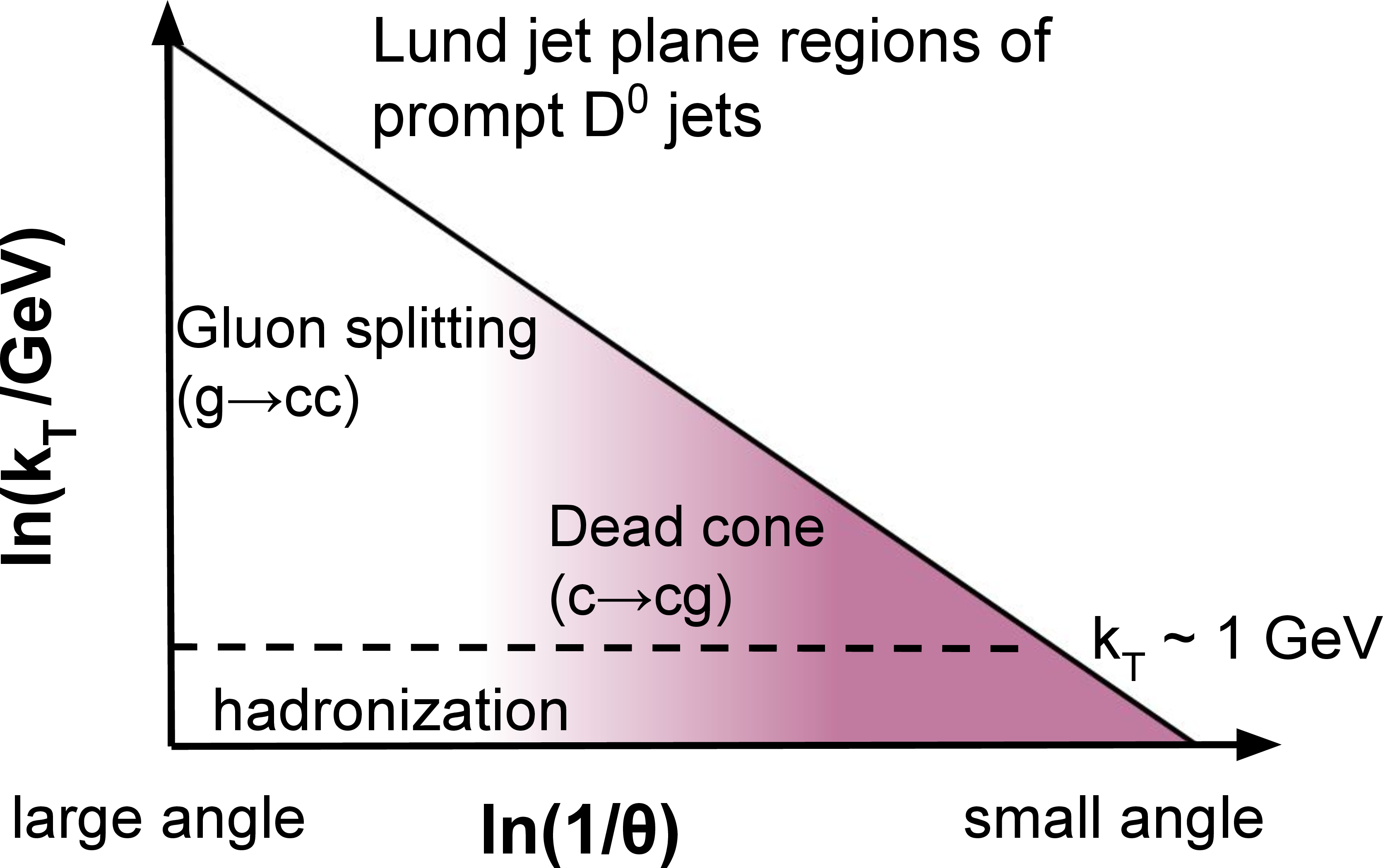
png pdf |
Figure 1-b:
Left: Schematic diagram of two subjets, with their splitting angle θ and the relative transverse momentum kT of the softer subjet with respect to the harder subjet. Right: Different Lund jet plane regions for charm quark jet showers. The vertical axis is the logarithm of the relative momentum kT of the emission and θ the angle between the emission and the emitter. Gluon splitting to charm quark-antiquark pairs contribute primarily at large angles θ, hadronization effects contribute primarily to low kT< 1 GeV and the dead cone effect located at small angles. |

png pdf |
Figure 2:
Comparison of the ln(1/θl) distributions for different windows of the invariant mass of the track pairs and the inclusive jets selection. The black rectangles represent the selection for D0 meson candidates in the resonance region (dominated by signal D0 meson candidates), the red circles represent D0 meson candidates from the mass sideband region (dominated by combinatorial background), and green triangles represent the inclusive jet. In the lower pannel, a ratio to nominal signal is shown. The error bands represent the statistical uncertainties. |

png pdf |
Figure 3:
Left: Detector-level DCA significance distribution in data fitted with PYTHIA8 CP5 templates for prompt and nonprompt D0 mesons contained in jets. In the lower panel, the ratio between the data and the fit values is presented. Right: Measured D0 meson yields (black circles) and nonprompt D0 meson contribution (filled histogram) as function of the late kT splitting angle θl. |
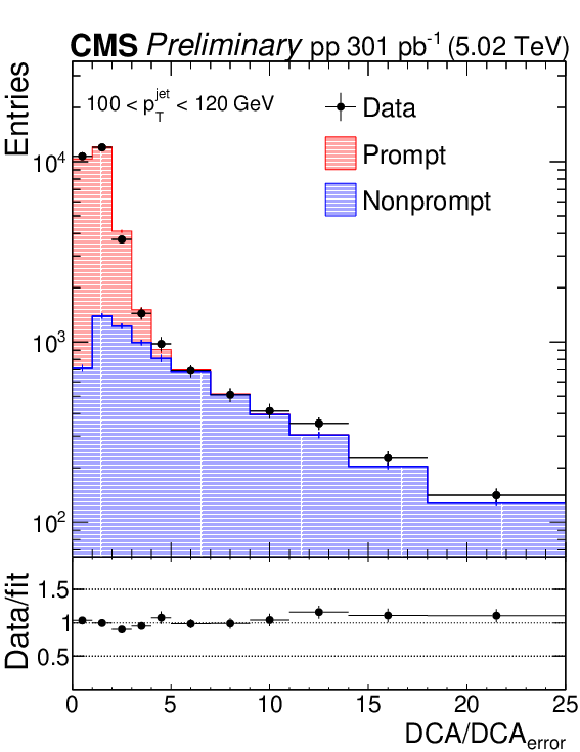
png pdf |
Figure 3-a:
Left: Detector-level DCA significance distribution in data fitted with PYTHIA8 CP5 templates for prompt and nonprompt D0 mesons contained in jets. In the lower panel, the ratio between the data and the fit values is presented. Right: Measured D0 meson yields (black circles) and nonprompt D0 meson contribution (filled histogram) as function of the late kT splitting angle θl. |
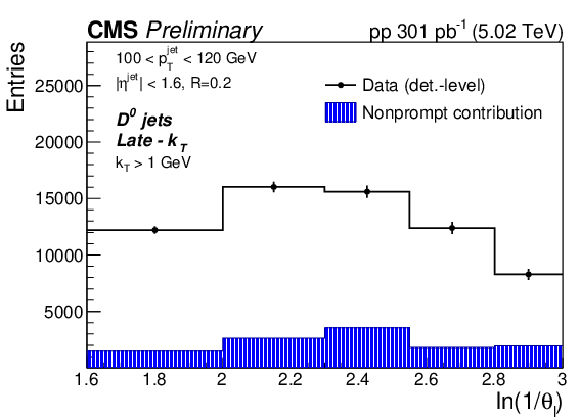
png pdf |
Figure 3-b:
Left: Detector-level DCA significance distribution in data fitted with PYTHIA8 CP5 templates for prompt and nonprompt D0 mesons contained in jets. In the lower panel, the ratio between the data and the fit values is presented. Right: Measured D0 meson yields (black circles) and nonprompt D0 meson contribution (filled histogram) as function of the late kT splitting angle θl. |

png pdf |
Figure 4:
The unfolded late-kT angular distribution for prompt D0 jets (left) and inclusive jets (right) compared with predictions from PYTHIA8 CP5 and HERWIG 7 CH3. The error bands in the upper panel represent the total systematical uncertainty, whereas the vertical bars represent the statistical uncertainties. In the lower panel, the error band in the ratio plot represents the total experimental uncertainty from the measurement. |
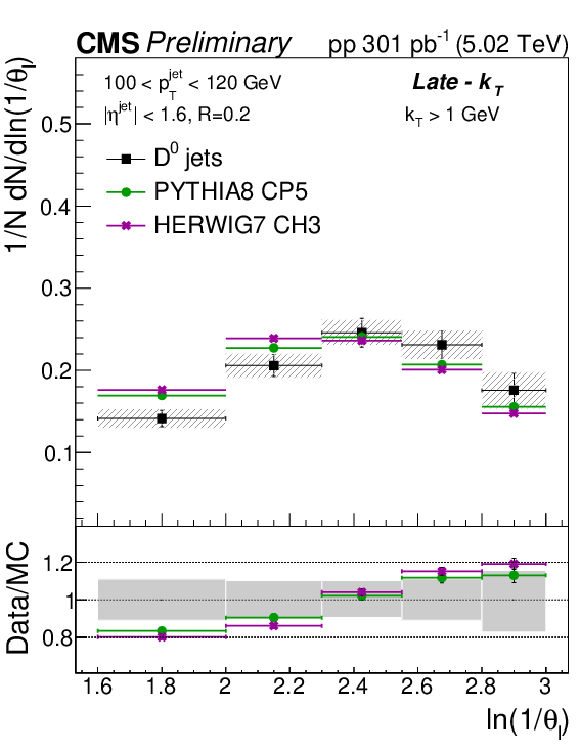
png pdf |
Figure 4-a:
The unfolded late-kT angular distribution for prompt D0 jets (left) and inclusive jets (right) compared with predictions from PYTHIA8 CP5 and HERWIG 7 CH3. The error bands in the upper panel represent the total systematical uncertainty, whereas the vertical bars represent the statistical uncertainties. In the lower panel, the error band in the ratio plot represents the total experimental uncertainty from the measurement. |
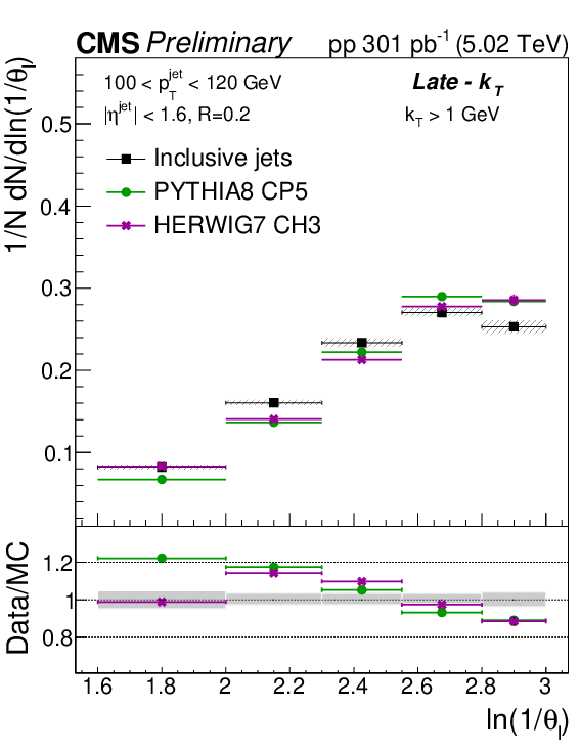
png pdf |
Figure 4-b:
The unfolded late-kT angular distribution for prompt D0 jets (left) and inclusive jets (right) compared with predictions from PYTHIA8 CP5 and HERWIG 7 CH3. The error bands in the upper panel represent the total systematical uncertainty, whereas the vertical bars represent the statistical uncertainties. In the lower panel, the error band in the ratio plot represents the total experimental uncertainty from the measurement. |

png pdf |
Figure 5:
The unfolded soft-drop angular distribution for prompt D0 jets (left) and inclusive jets (right) compared with predictions from PYTHIA8 CP5 and HERWIG 7 CH3. The error bands in the upper panel represent the total systematical uncertainty, whereas the vertical bars represent the statistical uncertainties. In the lower panel, the error band in the ratio plot represents the total experimental uncertainty from the measurement. |
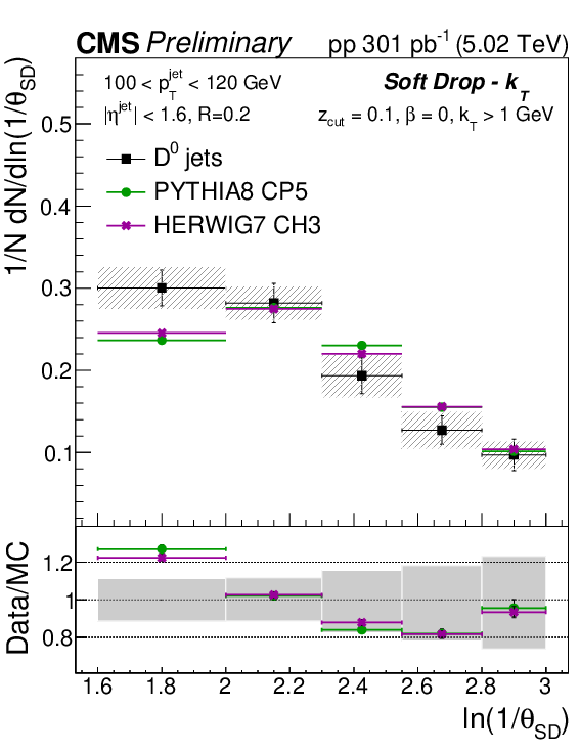
png pdf |
Figure 5-a:
The unfolded soft-drop angular distribution for prompt D0 jets (left) and inclusive jets (right) compared with predictions from PYTHIA8 CP5 and HERWIG 7 CH3. The error bands in the upper panel represent the total systematical uncertainty, whereas the vertical bars represent the statistical uncertainties. In the lower panel, the error band in the ratio plot represents the total experimental uncertainty from the measurement. |

png pdf |
Figure 5-b:
The unfolded soft-drop angular distribution for prompt D0 jets (left) and inclusive jets (right) compared with predictions from PYTHIA8 CP5 and HERWIG 7 CH3. The error bands in the upper panel represent the total systematical uncertainty, whereas the vertical bars represent the statistical uncertainties. In the lower panel, the error band in the ratio plot represents the total experimental uncertainty from the measurement. |

png pdf |
Figure 6:
The late-kT (upper plot) and modified soft-drop (lower plot) angular distribution for prompt D0 jets and inclusive jets. It the lower panels, the ratio to the inclusive jets is shown. The error band represents the total systematic uncertainty, whereas the vertical bars represent the statistical uncertainties. |
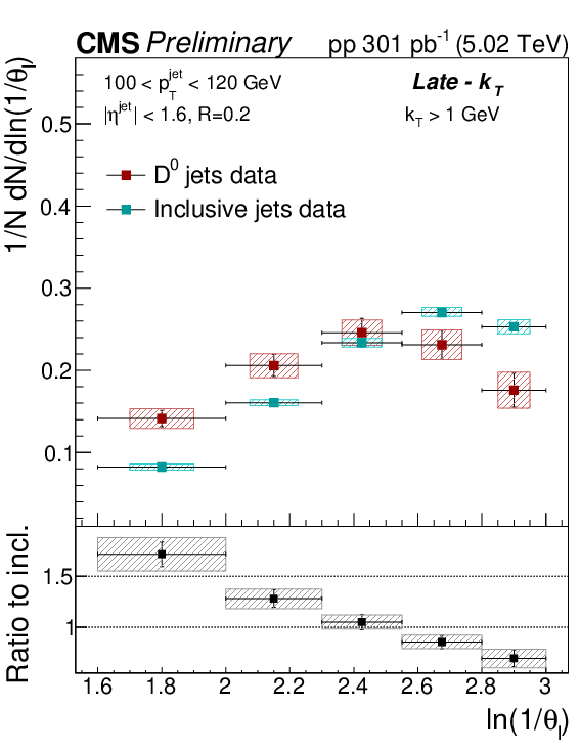
png pdf |
Figure 6-a:
The late-kT (upper plot) and modified soft-drop (lower plot) angular distribution for prompt D0 jets and inclusive jets. It the lower panels, the ratio to the inclusive jets is shown. The error band represents the total systematic uncertainty, whereas the vertical bars represent the statistical uncertainties. |
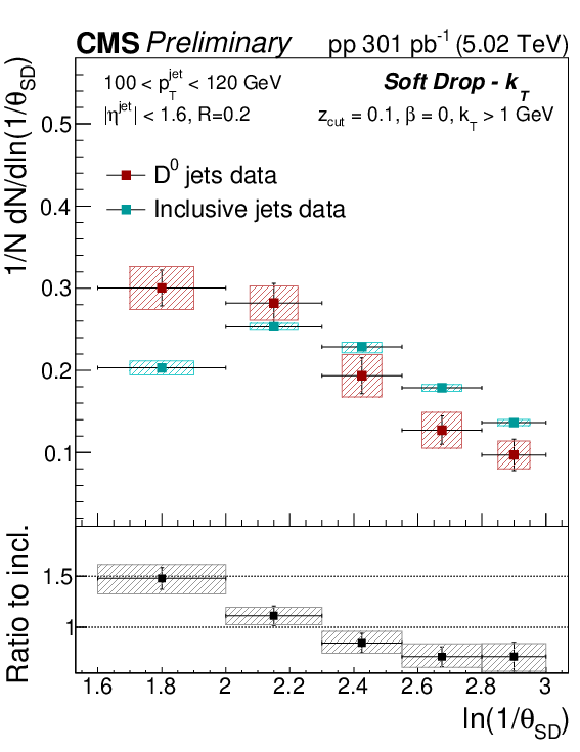
png pdf |
Figure 6-b:
The late-kT (upper plot) and modified soft-drop (lower plot) angular distribution for prompt D0 jets and inclusive jets. It the lower panels, the ratio to the inclusive jets is shown. The error band represents the total systematic uncertainty, whereas the vertical bars represent the statistical uncertainties. |

png pdf |
Figure 7:
The ratio of the late-kT angle distributions (left panel) and SD angle (right panel) for prompt D0 jets to inclusive jets, the data are compared with PYTHIA8 CP5 and HERWIG 7 CH3 with and without gluon splitting to charm quark-antiquark pairs. |

png pdf |
Figure 7-a:
The ratio of the late-kT angle distributions (left panel) and SD angle (right panel) for prompt D0 jets to inclusive jets, the data are compared with PYTHIA8 CP5 and HERWIG 7 CH3 with and without gluon splitting to charm quark-antiquark pairs. |
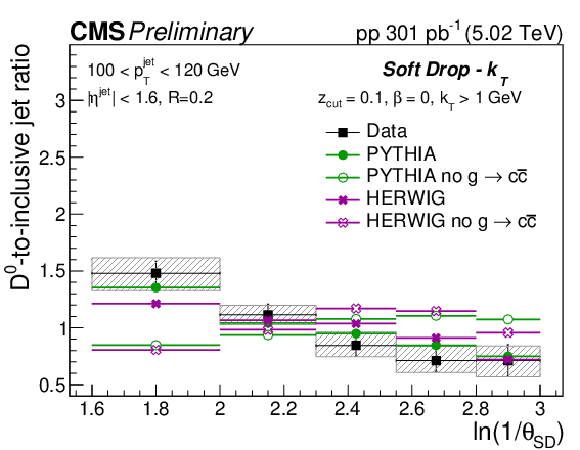
png pdf |
Figure 7-b:
The ratio of the late-kT angle distributions (left panel) and SD angle (right panel) for prompt D0 jets to inclusive jets, the data are compared with PYTHIA8 CP5 and HERWIG 7 CH3 with and without gluon splitting to charm quark-antiquark pairs. |
| Tables | |

png pdf |
Table 1:
Summary of percentual relative uncertainties. |
| Summary |
| This note has presented a measurement of the substructure of jets containing prompt D0 mesons and of inclusive jets in proton-proton (pp) collisions at a collision energy of √s= 5.02 TeV, corresponding to an integrated luminosity of 301 pb−1, collected in 2017 with the CMS experiment. The analysis focuses on the substructure of jets initially clustered with the anti-kT algorithm and a distance parameter of R= 0.2 with transverse momentum 100 <pjetT< 120 GeV and pseudorapidity |η|< 1.6. Both neutral and charged particles are used for the substructure of these jets. The D0 meson is identified via its two-pronged decay into a kaon and pion pair. The analysis focuses on the opening angle between the subjet pair found with two different grooming algorithms that are based on Cambridge-Aachen (CA) reclustering. The angular separation between the two hard subjets found with the soft-drop grooming algorithm is studied, using the parameters zcut= 0.1 and β= 0, with the additional requirement that the emission has a minimum relative transverse momentum of kT> 1 GeV. The splitting angle distribution, in this case, is sensitive to contributions from g→cˉc splitting at large angles and has sensitivity to the dead cone effect for small-angle emissions. The late-kT grooming algorithm, distinct from the soft-drop grooming case, gives access to hard, collinear emissions in an algorithmic way. The late-kT algorithm consists of selecting the last splitting with a kT> 1 GeV in the CA tree. The resulting angular distribution is more resilient to g→cˉc splittings and to soft- and wide-angle radiation, and is more sensitive to the dead cone effect. A stronger suppression with respect to the inclusive jet baseline is observed, as expected from the dead cone effect. This is the first measurement of charm quark jet substructure that probes the hard and collinear region of the jet shower, in a way such that the contribution from hadronization effects is reduced and the connection with the expected parton-level shower is more direct. The jet pT> 100 GeV selection, used for the first time for charm quark jet substructure, increases the phase space available for an interpretation of the jet substructure in terms of perturbation theory calculations. Although the jet pT is much larger than the charm quark mass, it is possible to isolate hard collinear emissions and observe the suppression due to the charm quark mass in the hard and collinear region. |
| References | ||||
| 1 | ALICE Collaboration | Direct observation of the dead cone effect in quantum chromodynamics | Nature 605 (2022) 440 | 2106.05713 |
| 2 | Y. L. Dokshitzer, V. A. Khoze, and S. I. Troian | On specific QCD properties of heavy quark fragmentation ('dead cone') | JPG 17 (1991) | |
| 3 | Y. L. Dokshitzer, G. D. Leder, S. Moretti, and B. R. Webber | Better jet clustering algorithms | JHEP 08 (1997) | hep-ph/9707323 |
| 4 | L. Cunqueiro and M. Ploskon | Searching for the dead cone effects with iterative declustering of heavy-flavor jets | PRD 99 (2019) 074027 | 1812.00102 |
| 5 | ALICE Collaboration | Measurement of the primary Lund plane density in pp collisions at √s= 13 TeV with ALICE | ALICE Physics Preliminary Summary ALICE-PUBLIC-2021-002, 2021 | |
| 6 | L. Cunqueiro, D. Napoletano, and A. Soto-Ontoso | Dead cone searches in heavy-ion collisions using the jet tree | PRD 107 (2023) 094008 | 2211.11789 |
| 7 | A. J. Larkoski, S. Marzani, G. Soyez, and J. Thaler | Soft drop | JHEP 05 (2014) 146 | 1402.2657 |
| 8 | J. M. Butterworth, A. R. Davison, M. Rubin, and G. P. Salam | Jet substructure as a new Higgs search channel at the LHC | PRL 100 (2008) 242001 | 0802.2470 |
| 9 | ALICE Collaboration | Measurements of groomed jet substructure of charm jets tagged by D0 mesons in proton-proton collisions at √s= 13 TeV | PRL 131 (2023) 192301 | 2208.04857 |
| 10 | CMS Collaboration | Luminosity measurement in proton-proton collisions at 5.02 TeV in 2017 at CMS | CMS Physics Analysis Summary CMS-PAS-LUM-19-001 |
CMS-PAS-LUM-19-001 |
| 11 | CMS Collaboration | The CMS experiment at the CERN LHC | JINST 3 (2008) S08004 | |
| 12 | CMS Collaboration | Development of the CMS detector for the CERN LHC Run 3 | Submitted to JINST, 2023 | CMS-PRF-21-001 2309.05466 |
| 13 | CMS Collaboration | Performance of the CMS Level-1 trigger in proton-proton collisions at √s= 13 TeV | JINST 15 (2020) P10017 | CMS-TRG-17-001 2006.10165 |
| 14 | CMS Collaboration | The CMS trigger system | JINST 12 (2017) P01020 | CMS-TRG-12-001 1609.02366 |
| 15 | CMS Collaboration | Electron and photon reconstruction and identification with the CMS experiment at the CERN LHC | JINST 16 (2021) P05014 | CMS-EGM-17-001 2012.06888 |
| 16 | CMS Collaboration | Performance of the CMS muon detector and muon reconstruction with proton-proton collisions at √s= 13 TeV | JINST 13 (2018) P06015 | CMS-MUO-16-001 1804.04528 |
| 17 | CMS Collaboration | Description and performance of track and primary-vertex reconstruction with the CMS tracker | JINST 9 (2014) P10009 | CMS-TRK-11-001 1405.6569 |
| 18 | CMS Collaboration | Particle-flow reconstruction and global event description with the CMS detector | JINST 12 (2017) P10003 | CMS-PRF-14-001 1706.04965 |
| 19 | CMS Collaboration | Performance of reconstruction and identification of τ leptons decaying to hadrons and ντ in pp collisions at √s= 13 TeV | JINST 13 (2018) P10005 | CMS-TAU-16-003 1809.02816 |
| 20 | CMS Collaboration | Jet energy scale and resolution in the CMS experiment in pp collisions at 8 TeV | JINST 12 (2017) P02014 | CMS-JME-13-004 1607.03663 |
| 21 | CMS Collaboration | Performance of missing transverse momentum reconstruction in proton-proton collisions at √s= 13 TeV using the CMS detector | JINST 14 (2019) P07004 | CMS-JME-17-001 1903.06078 |
| 22 | M. Cacciari, G. P. Salam, and G. Soyez | The anti-kT jet clustering algorithm | JHEP 04 (2008) 063 | 0802.1189 |
| 23 | M. Cacciari, G. P. Salam, and G. Soyez | FastJet user manual | EPJC 72 (2012) 1896 | 1111.6097 |
| 24 | H. A. Andrews et al. | Novel tools and observables for jet physics in heavy-ion collisions | JPG 47 (2020) 065102 | 1808.03689 |
| 25 | CMS Collaboration | Determination of jet energy calibration and transverse momentum resolution in CMS | JINST 6 (2011) P11002 | CMS-JME-10-011 1107.4277 |
| 26 | Particle Data Group Collaboration | Review of Particle Physics | PTEP 2022 (2022) 083C01 | |
| 27 | H. Voss, A. Höcker, J. Stelzer, and F. Tegenfeldt | TMVA, the toolkit for multivariate data analysis with ROOT | in XIth International Workshop on Advanced Computing and Analysis Techniques in Physics Research (ACAT), 2007 [PoS (ACAT) 040] |
physics/0703039 |
| 28 | T. Sjöstrand et al. | An introduction to PYTHIA8.2 | Comput. Phys. Commun. 191 (2015) 159 | 1410.3012 |
| 29 | CMS Collaboration | Extraction and validation of a new set of CMS PYTHIA8 tunes from underlying event measurements | EPJC 80 (2020) 4 | CMS-GEN-17-001 1903.12179 |
| 30 | S. Gieseke, P. Stephens, and B. Webber | New formalism for QCD parton showers | JHEP 12 (2003) 045 | hep-ph/0310083 |
| 31 | NNPDF Collaboration | Parton distributions for the LHC Run 2 | JHEP 04 (2015) 040 | 1410.8849 |
| 32 | B. R. Webber | A QCD model for jet fragmentation including soft gluon interference | NPB 238 (1984) 492 | |
| 33 | CMS Collaboration | Development and validation of HERWIG 7 tunes from CMS underlying event measurements | EPJC 81 (2021) 312 | CMS-GEN-19-001 2011.03422 |
| 34 | GEANT4 Collaboration | GEANT 4---a simulation toolkit | NIM A 506 (2003) 250 | |
| 35 | P. Skands, S. Carrazza, and J. Rojo | Tuning PYTHIA8.1: the Monash 2013 tune | EPJC 74 (2014) 3024 | 1404.5630 |
| 36 | CMS Collaboration | Event generator tunes obtained from underlying event and multiparton scattering measurements | EPJC 76 (2016) 155 | CMS-GEN-14-001 1512.00815 |
| 37 | M. Wobisch and T. Wengler | Hadronization corrections to jet cross sections in deep inelastic scattering | in Workshop on Monte Carlo generators for HERA physics, 1998 link |
hep-ph/9907280 |
| 38 | S. Caletti, A. Ghira, and S. Marzani | On heavy-flavor jets with soft drop | EPJC 84 (2024) 212 | 2312.11623 |
| 39 | G. D'Agostini | A multidimensional unfolding method based on Bayes' theorem | NIM A 362 (1995) 487 | |
| 40 | T. Adye | Unfolding algorithms and tests using RooUnfold | in PHYSTAT 2011 Workshop on Statistical Issues Related to Discovery Claims in Search Experiments and Unfolding, H. Prosper and L. Lyons, eds., Geneva, Switzerland, 2011 link |
1105.1160 |
| 41 | CMS Collaboration | Single-particle response in the CMS calorimeters | CMS Physics Analysis Summary, 2010 link |
|
| 42 | CMS Collaboration | Measurements of azimuthal anisotropy of nonprompt D0 mesons in PbPb collisions at √sNN= 5.02 TeV | PLB 850 (2024) 138389 | CMS-HIN-21-003 2212.01636 |
| 43 | CMS Collaboration | Study of quark and gluon jet substructure in Z+jet and dijet events from pp collisions | JHEP 01 (2022) 188 | CMS-SMP-20-010 2109.03340 |
| 44 | CMS Collaboration | Measurement of the primary Lund jet plane density in proton-proton collisions at √s= 13 TeV | JHEP 05 (2024) 116 | CMS-SMP-22-007 2312.16343 |

|
Compact Muon Solenoid LHC, CERN |

|

|

|

|

|

|